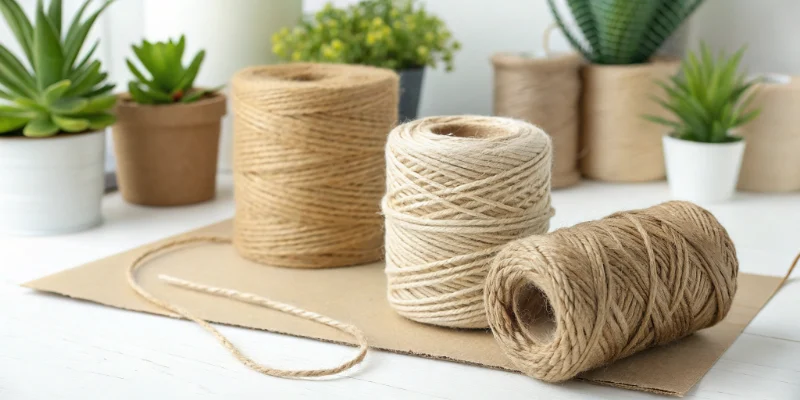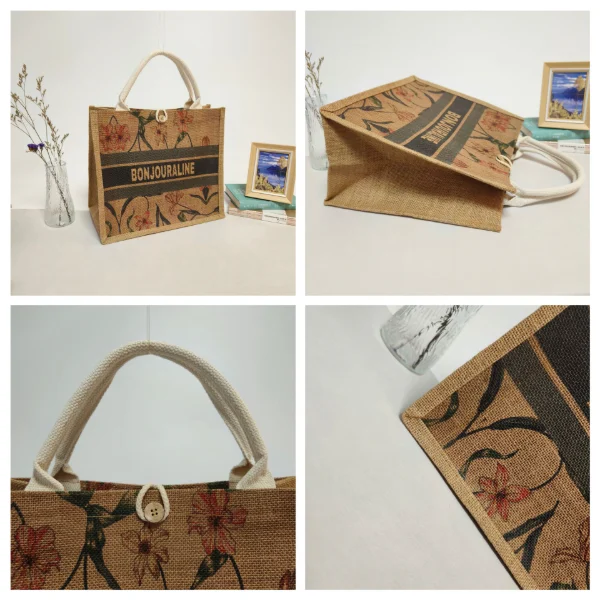Our Academy

Jute, also known as the “golden fiber,” is a natural fiber derived from the stalks of plants belonging to the Corchorus genus of the Tiliaceae family. It is not only strong and durable with a natural sheen, but also renewable and biodegradable—making it one of the most sustainable eco-friendly materials today. From traditional burlap and ropes to its modern applications in eco-packaging, home décor, and reusable shopping bags, jute—with its distinctive natural texture and low carbon footprint—is redefining the concept of a green lifestyle.
Jute is a natural long fiber extracted from the stalks of plants in the Corchorus genus under the Tiliaceae family. Known for its golden color and flexible texture, jute is primarily composed of cellulose and lignin, giving it strength, breathability, and the ability to naturally decompose. Major producing regions include India, Bangladesh, China, and Thailand, where it has been used for centuries to make ropes, sacks, and coarse jute cloth.
Jute takes only 4–6 months from sowing to harvest and requires almost no irrigation, fertilizer, or pesticide during cultivation. It grows naturally in ordinary soil, making it a typical low-carbon and low-impact crop.
Jute fibers are extracted through a traditional retting process, using natural microorganisms to break down plant gum. This method requires no chemicals and produces no wastewater or harmful emissions. The entire process is low-energy and low-emission, representing a truly green production technique.
Composed of cellulose and lignin, jute is 100% naturally biodegradable and leaves no microplastic residue. Even when burned, it produces only a small amount of natural ash that can be used as organic fertilizer—completing a full ecological recycling loop.
Jute products are strong and durable, capable of repeated use for many years. After their lifespan, they can be recycled into pulp, geotextiles, or compost—perfectly fitting the zero-waste concept and embodying a truly sustainable material.
From cultivation to processing and recycling, jute generates almost no pollution. Its renewable, biodegradable, and low-carbon nature makes it one of the most representative sustainable natural fibers today and an ideal material for eco bags and green packaging.

Jute is a biodegradable material. True
Jute is a natural fiber that is biodegradable, making it an environmentally friendly option.
Jute is naturally resistant to UV radiation. False
Jute is not naturally resistant to UV radiation but can be treated with chemicals to improve UV stability.
Jute is an annual herbaceous plant mainly cultivated in India, Bangladesh, and parts of China. It includes two main species: Corchorus capsularis (white jute) and Corchorus olitorius (tossa jute). The plant grows rapidly, reaching maturity within 4–6 months. It requires no fertilizers or pesticides and can thrive in ordinary soil, making it a typical low-carbon crop. Farmers usually sow jute during the rainy season and harvest it when the stalks turn yellow and start to flower—ensuring optimal fiber strength and luster.
After harvesting, the jute stalks are bundled and soaked in rivers, ponds, or water channels for 15–30 days—a process known as “retting.” During this stage, natural microorganisms in the water break down the pectin and lignin within the plant, loosening the fibrous material for easy extraction. The duration of soaking, water flow, and quality all affect the softness, color, and flexibility of the final fibers.
Once softened, the fibers are stripped from the woody core by hand—a process called “stripping.” Traditionally done manually, some areas now use simple mechanical tools to improve efficiency. The extracted fibers are rinsed thoroughly to remove any remaining impurities or mud and then sun-dried to restore their natural golden sheen.
After drying, the fibers are graded based on length, strength, color, and luster. The finest long fibers are used for spinning and weaving, while the coarser or shorter ones are utilized for ropes and packaging materials. Once sorted, the jute is compressed into standardized bales and shipped to textile mills or exported as raw material.
At the mill, the jute fibers undergo softening and carding to improve flexibility and spinnability. Through humidification and oil treatment, the fibers become smoother before being drawn and twisted into strong jute yarns. These yarns are then woven into burlap or hessian fabric, forming the base for later processes such as dyeing, lamination, printing, and stitching. Weaving can be done on traditional handlooms or modern machinery to enhance texture density and production efficiency.
From field to fiber, jute production relies almost entirely on natural processes with no chemical additives, minimal energy use, and very low emissions. It is not only the primary material for eco-friendly bags but also a cornerstone of the sustainable textile industry’s future.

Jute fiber is a natural long fiber extracted from the stalks of the jute plant, known for its strength, breathability, and biodegradability. Combining high tensile durability with a natural texture, it is widely used in eco-friendly bags, ropes, packaging fabrics, and decorative textiles—making it one of the most sustainable natural fibers today.
Jute fibers are long, slightly coarse, yet flexible. Composed mainly of cellulose and lignin, these natural polymers give jute its strength and biodegradability. Its porous structure also provides excellent moisture absorption and ventilation compared with most other natural fibers.
Jute fibers have exceptional tensile strength and are resistant to tearing or breaking. Burlap or hessian fabrics made from jute are sturdy and wear-resistant, commonly used in shopping bags, sandbags, and industrial fabrics—offering greater durability than cotton or nonwoven materials.
With its natural microporous texture, jute quickly absorbs and releases moisture, keeping contents dry and ventilated. This makes it ideal for packaging items such as food, produce, and clothing that require air circulation.
Jute has a golden or light brown sheen with a coarse yet natural texture, often described as having a “rustic look.” Its organic aesthetic makes it popular in eco-friendly branding, home décor, and sustainable fashion designs.
Jute is 100% biodegradable and compostable, producing no toxic emissions when burned. It requires little water and no pesticides during cultivation. Known as the “Golden Fiber,” it represents an eco-conscious, low-carbon, and sustainable lifestyle.
Strong, breathable, and environmentally friendly, jute fiber is an ideal material for sustainable products. Whether used in reusable bags, packaging, or fashion items, its natural appeal and low ecological impact make it a green alternative to plastics and synthetic fibers.
Jute is widely used for making sacks, bags, and textiles. True
Jute is commonly used to make sacks, bags, carpets, and textiles due to its strength and durability.
Jute is stronger than synthetic fibers like nylon. False
While jute is strong, it is not as strong or durable as synthetic fibers like nylon, which are designed to handle more extreme conditions.
With its strength, breathability, and biodegradability, jute is widely used across textiles, packaging, home décor, and agriculture. From traditional burlap and ropes to modern eco-friendly bags and fashion accessories, jute has found applications throughout both industry and daily life.
This is the most typical and well-established use of jute. After being spun and woven, jute is used to produce fabric rolls, shopping bags, jute sacks, and ropes. These products combine practicality with sustainability, making jute an ideal material for reusable and eco-conscious packaging.
The natural texture and warm tones of jute make it highly valued in home décor. It is often used for rugs, curtains, table runners, and furniture coverings, adding a sense of organic comfort to interior spaces. In Western markets, jute carpets and handcrafted home accessories are particularly popular for their eco-friendly and artisanal appeal.
Thanks to its durability and resistance to wear, jute is widely used in making burlap sacks, sandbags, and transport packaging. Its breathable nature prevents moisture buildup and mold, making it ideal for storing and shipping agricultural products, grains, and construction materials.
Because it is naturally biodegradable, jute plays an important role in sustainable agriculture. It is used for erosion-control fabric, seedling mats, compost bags, and plant support ropes. After use, these materials can decompose directly into the soil, improving aeration and moisture retention without causing pollution.
With the rise of sustainable fashion, jute has become a favorite material among designers. It is used to make handbags, footwear, hats, and belts, often combined with cotton, canvas, or leather to create eco-friendly products that balance natural texture with modern aesthetics.
From raw fiber to fabric, and from everyday goods to industrial materials, jute demonstrates remarkable versatility and sustainability. It is more than just a natural fiber—it represents a truly sustainable solution. As global interest in eco-friendly materials grows, jute is being rediscovered and reimagined by more brands and industries around the world.

In the global movement toward sustainability, the jute industry has become an essential part of the green economy. More than just an eco-friendly material, jute serves as a key link connecting ecological agriculture, circular manufacturing, and social responsibility.
As one of the few natural resources balancing environmental and economic benefits, jute grows quickly, requires little energy, and is gentle on the soil. Many countries have integrated jute into their sustainability strategies, while governments and international organizations are promoting its modernization and standardization to strengthen its role in the green supply chain.
Today, jute is no longer viewed merely as a “packaging material,” but as a core element of corporate ESG initiatives. More and more companies are adopting jute products to reduce carbon emissions and enhance their sustainability image, transforming jute from a raw material into a valuable brand sustainability asset.
At the same time, the jute industry plays an important social role, providing rural employment opportunities in countries such as Bangladesh and India, particularly supporting women’s economic independence and community development.
The value of jute now extends far beyond its material form. It symbolizes the future of sustainable manufacturing and green trade—an essential benchmark of what true sustainability means in modern industries.
The significance of jute extends far beyond that of a natural fiber. With its low-energy growth process, biodegradability, and wide range of applications, jute has become a key material in the global sustainability framework. From agriculture to manufacturing, from packaging to design, jute proves that environmental responsibility and practicality can truly coexist. For both brands and consumers, choosing jute is more than selecting a material—it is embracing a lifestyle that lives in harmony with nature.
Looking for eco-friendly, stylish, and durable packaging solutions? Yanxin Bag specializes in customized jute bags, eco-friendly tote bags, and sustainable packaging products. With premium craftsmanship and international production standards, we provide one-stop customization services—from design and printing to bulk manufacturing—tailored to meet the needs of brands, retailers, and corporate clients.
Whether you are planning for brand promotions, retail packaging, or sustainable alternatives, Yanxin Bag offers the perfect custom jute bag solution. Contact us today and let your brand be seen through a natural, sustainable, and impactful way.
Curious about how jute bags fit into daily use?
This guide covers what jute bags are, where they come from, how they’re made, and their everyday applications — ideal for understanding jute’s practical and sustainable potential.
Deciding between jute and canvas? This breakdown helps.
The article compares jute and canvas bags across durability, printability, upkeep, and visual feel, helping you determine which material best suits your goals.
Wonder how a jute bag is made from plant to product?
From plant processing to cutting, stitching, and assembling, this piece details each stage of the eco-conscious production process behind every jute bag.
Need supply consistency and better cost control?
This article explains how bulk purchasing supports better pricing, planning, and production coordination — especially useful for businesses with recurring packaging needs.
Want your jute bags to reflect your brand?
It walks through all customizable options — including size, handles, lining, and print areas — and shows how each can enhance your packaging’s impact and brand identity.
Get a free quote and expert consultation today. Let's bring your brand vision to life.
FAO – Overview of the Jute Industry
Indian Jute Industries Research Association (IJIRA) – Jute Fiber Research and Reports
Bangladesh Jute Research Institute (BJRI) – Environmental Study on Jute
Textile Exchange – Preferred Fiber & Materials Market Report
Ellen MacArthur Foundation – Circular Materials and Sustainable Packaging
1 Understanding carbon dioxide absorption can highlight the environmental benefits of jute cultivation.
2 Discover how the jute industry aligns with the SDGs and promotes sustainability and inclusivity.
Answer: A jute bag is a reusable bag made from natural jute fiber (derived from the Corchorus plant genus), which is woven into fabric and then cut and stitched into a bag. It combines durability, breathability and biodegradability, making it an eco-friendly packaging solution.
Answer: A tote bag typically refers to a reusable bag made of canvas, cotton or synthetic fibers, designed for everyday carry. A jute bag, by contrast, is specifically made from jute fiber and offers a more rustic texture, natural aesthetic and higher biodegradability. Many brands use jute bags for sustainable packaging and eco-friendly branding.
Answer: With proper care, jute bags can last up to 4 years or more. They are highly durable but should be kept dry to prevent mold and mildew.
Answer: Yes, jute bags can shrink if washed in a machine. It is recommended to hand wash or spot clean them to maintain their size and shape.
Answer: Jute bags are not naturally water-resistant. They absorb moisture, so it’s essential to keep them dry to avoid mold and mildew growth.
Answer: Jute is a renewable plant-based natural fibre, requires minimal pesticides and water, and is 100% biodegradable; plastic, on the other hand, is petroleum-based, emits microplastics, and often ends up in landfills. Using jute supports lower-carbon materials and circular-economy packaging.
Answer: Jute bags are good for reusable shopping, gift-packaging, promotional giveaways, eco-friendly retail packaging and fashion accessories where a sustainable, natural look is desired. They provide durable, breathable, biodegradable options for brands.
Answer: To keep jute bags in good condition, store them in a dry, cool place, and avoid folding them to prevent wrinkles and maintain their shape.
Answer: The main jute-producing regions are India, Bangladesh and parts of China, particularly the Ganges-Brahmaputra delta. Cultivation in these areas typically needs fewer chemical inputs and supports rural livelihoods—aligning with sustainable agriculture and fair-trade practices.
Answer: Jute bags can be repurposed for various uses, such as home decor, pet beds, gardening, or storage. Their durability and recyclability make them perfect for creative upcycling.

Order or no-order we are Always here to help you!
We will contact you within 1 working day, please pay attention to the email with the suffix “@yanxinbag.com”.
Order or no-order we are Always here to help you!
We will contact you within 1 working day, please pay attention to the email with the suffix “@yanxinbag.com”.